Soul Sacrifice Review
Sony’s Japan Studio are beginning to make a name for themselves as a development outfit who simply can’t be predicted. Titles like Tokyo Jungle and Gravity Rush have shown a side to the developer that matches Grasshopper Manufacture’s penchant for blasting games straight out of left field, that may not rewrite the rule book but that aren’t afraid to tear pages out where necessary. Their recent games have been kooky, sure, but also original and well-made (well, maybe not Tokyo Jungle), and PlayStation Vita-exclusive Soul Sacrifice follows suit. As Martin revealed after his early play of the demo, it’s a game that’s full of surprises.
Although the “Sacrifice” in the title might leave you in mind of redemption and honour, Soul Sacrifice is a game about murder. Murder is at the heart of the narrative – it’s what motivates the characters, it’s what feeds their power. It’s not a pleasant game with a hopeful story – the only other fantasy RPG I’ve ever played that comes close to sharing Soul Sacrifice’s absolute certainty of a grim ending is Dark Souls. There’s a sense throughout Soul Sacrifice that even should you win, you will lose. Its world is a dark place built on absolutes, where monsters stalk the wild lands and your very desires can see you transformed into an inhuman abomination that must be destroyed with utter and extreme prejudice.
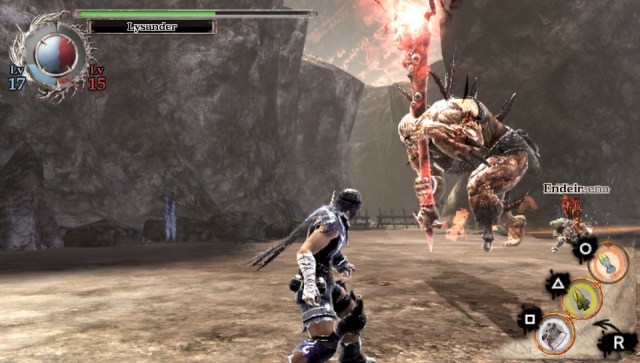
The backstory of Soul Sacrifice is much deeper and more complex than the demo insinuated, because its more subtle nuances and intricate tangents remain unexplored for the first two or three hours of play. The world is cursed, that much is revealed early on. An ancient artifact known as the Chalice has the power to grant the wishes of any whose desire is perceived as strong enough. It’s the closest thing to a deity in Soul Sacrifice, and is rumoured to have brought the world back from the brink of Armageddon on several occasions in the past. The power of desire is incredibly potent, more effective than any form of magic or energy, but when desire crosses the line into greed and avarice, the power of the Chalice corrupts. Because the world is in such chaos and disarray, poverty, disease and suffering are rife – in a world like that, desire and greed straddle a fine line in the hearts of all. As a result, monsters are an unstoppable plague. When an animal is influenced by an overflow of the Chalice’s power, it becomes a mutated carnivore; when a human is infected – especially one who has been touched by sorcery – they become a doppelganger, a colossal abomination that spreads death and despair wherever it goes.
To combat these monsters, a sect of Sorcerers exists in the citadel of Avalon that make the ultimate sacrifice to keep humanity safe. The most powerful sorcery is born from pain and blood and death, and so a Sorcerer derives his or her strength from the murder of monsters and – more often than not – the poor souls who have become them, even after they’ve reverted to their human form. When the story begins, your character is imprisoned by the Sorcerer Magusar, an incredibly dangerous psychopath who devours humans to remain immortal. After watching the failed escape attempt of a fellow prisoner, you find a book buried under the bones and waste in your cell. It’s a living book called the Librom, the diary of a Sorcerer who was once Magusar’s companion. The Librom tells you that by reading it, you will relive the life of the author in “phantom quests”, and in doing so will steadily take on his power and knowledge until you’re strong enough to challenge Magusar and win. Interestingly, you can chooses to challenge Magusar at any time to prevent the destruction of the world, even before you’ve completed a single quest. But if you lose, and you will, it’s game over. It’s not worth attempting until way, way later.
After a fairly unhelpful, deep-end tutorial, the opening few hours take the form of a series of missions in a quest-line called The Ordeal. You’ll learn to fight alongside a fellow Sorceress named Sortiara in what passes for an all-or-nothing final exam to be accepted into Avalon. Two Sorcerers partner up and whichever returns from the Ordeal is granted Sorcerer status. Sometimes it’s both, but if ever one Sorcerer falls to a mortal wound, the only acceptable option is for the survivor to sacrifice them. A wounded Sorcerer, even if saved, can be infected by the monster that struck the blow and corrupted – and it’s not a risk worth taking. It’s during the Ordeal that you’ll get your first proper taste of combat, an alchemical brew equal parts Ragnarok Odyssey, The Witcher 2 and Dark Souls. Before that sentence wakes the trolls, I’m not saying for one moment that Soul Sacrifice’s combat is as refined or considered as either of the last two – that’s where the Ragnarok Odyssey ingredient flavours the concoction. Rather, the onus on evasive manoeuvres, timed counters and mixing many types of offensive and defensive skills gives off the warm scent of From Software’s harrowing behemoth, and the use of various reagents and the monster-slaying focus tangs of CDProjekt RED’s incredible Action-RPG.
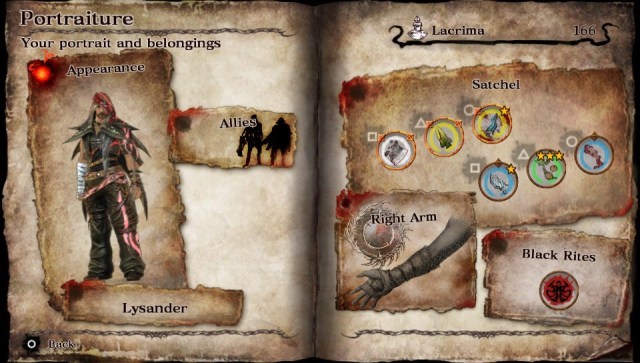
All your skills in the field come from “offerings”, sacrificial trinkets that can be anything from animal claws to eggs, rocks or sand. I don’t know exactly how many there are, but given the massive variety and several levels of strength, there are likely well over two-hundred. So for example, a certain type of sapling can be sacrificed to temporarily transform your arm into a sword that deals earth damage (obeying the standard laws of elemental diversity whereby fire is strong against earth, ice is strong against fire, etc), or the sacrificed shell of a boulderbug beetle that covers your soft skin in stone and allows you to roll yourself into an enormous ball to be launched at your opponents. Seedpods can be offered for healing, you can bury plant spores to create special trees that produce fruit with buffing properties (especially useful in multiplayer), and animal fangs can transform your arm into a canon that spews fire, lightning or biting wind. In the portraiture section of the Librom, two of the same offerings can be combined to increase the number of casts per use, and different offerings can be “fused” into entirely new ones.
Magic comes in a massive variety of types: Burrowing magic conjures powerful arcane roots that target your enemy from below; Throw magic gives you ranged attacks; Summon magic conjures mighty golems to fight for you. If you had access to all of them at once you’d be unstoppable, but tactics must be employed because you can only take six offerings into any phantom quest, and every single one has an incredibly limited number of uses. While Soul Sacrifice doesn’t punish failure as harshly as other games, repeatedly losing to a tough enemy will see your offerings and allies dwindle (although you can always grind the multiplayer to re-balance the scales).
A good mix of ranged, melee, healing and support offerings is essential for the tougher fights, but when an offering is used up it’s gone until the quest is done, and so each must be renewed when possible. Special areas in each map allow the summoning of temporary weapons and armour, or else offer one-use fountains that renew your spells. Failing that, the only option is to sacrifice your enemies (or your allies, of course). Every monster in Soul Sacrifice is a twisted version of something earthly: Orcs are huge, slug-like mutated cats while Goblins are rats weighed down with gold, fungus or body parts, and killing them leaves the original animal at your mercy. If you save them, you get a small refill of life and Divine experience; if you sacrifice them, you renew your offerings by one use and receive Dark experience. The Divine and Dark experience alludes to your right arm (where every Sorcerer’s power resides) – the higher your Divine level, the higher your defence and health; the greater your Dark level, the more potent your attacks and offerings. During a battle it’s essential to balance your saves and sacrifices to maintain the upper hand, especially when fighting bosses.
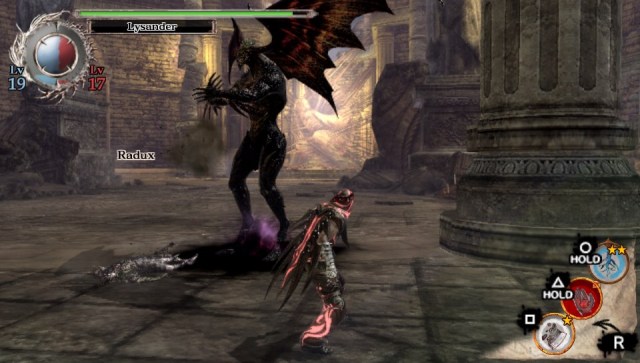
The Archfiends (or doppelgangers) are often gigantic, ranging from winged wyverns to a towering cyclops, to building-sized balls of slime. They’re often grotesque and always a challenge, even though they all take the form of fairly standard boss encounters: each has certain weaknesses, many strengths, the occasional unblockable haymaker, lots of area-of-effect attacks and a megaton of hit-points. Killing them often presents a moral choice based on the story behind the individual monster. For example, one story features a woman who was kidnapped, forcing her husband to want her back so desperately that he mutated into a monster. After you kill him, the woman goes mad and she becomes corrupted too – but the man’s soul, now bound to Magusar’s right arm, pleads with you to save his wife’s life. You’d have to have a hard heart to kill her when she’s on her knees begging – and if you save her, she’ll even join your group of allies.
The combat is exhilarating and often challenging on an almost hardcore level, such is the plethora of options and tactics and resultant possibility of simply taking the wrong offerings into a fight. The action controls like a standard third-person action game, with a target lock assigned to the left trigger and a diving roll and the offerings mapped to the face buttons (right trigger switches between two sets of three offerings). Sometimes it gets so frantic that the camera has a bit of trouble, and the target lock can occasional hinder you as it only takes a touch of the right stick (which also controls the camera) to instantly switch targets. Also, casting anything takes time, and while you might only spend a second or two locked in an animation to summon a sword made of ice, it’s precious time for an enemy to canon into you and knock you down.
There are no issues with slow-down or dodgy texturing to spoil the fun, but spacial awareness and evasion is key to survival. When you reach a low enough level of health, you can touch the screen to activate a Black Rite, which sacrifices some part of your flesh to cast an immense, atomic bomb of a spell that will even cut the health of a boss in half. Unfortunately, you will pay a price. For example, the Infernus rite will burn off your skin and leave you with 50% defence forever, unless you “undo” the cost using Lacrima, a special substance awarded after every quest, derived from the Librom’s tear-drops. Much better to sacrifice a wounded ally instead – you’ll do the same damage and pay no penance. It really is good to be bad in Soul Sacrifice – although sacrificing your own life for the good of others can bring about its own rewards, too.
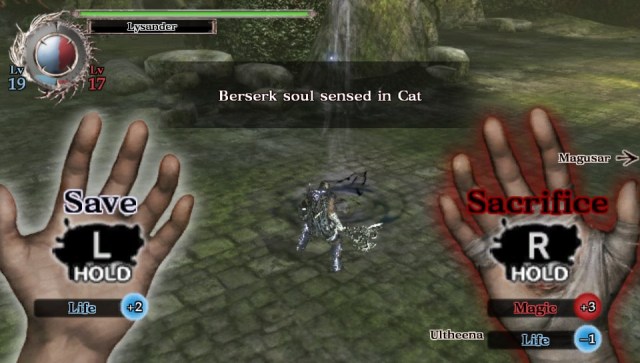
While the lesser quests are often fairly straightforward (and not all that varied, spread as they are between extermination quests, item collection and exploration), they are occasionally spiced up by imposed conditions such as time limits or the inclusion of areas in the map that buff or debuff you when you linger on them too long. The main campaign tasks you with reliving the life of the author as he travels with Magusar in search of the Chalice, and meets various other Sorcerers in the last days before the end of the world, but an abundance of side-quests keep you busy outside the narrative. Avalon Pacts are special quest-lines that you can undertake with up to two AI companions (drawn from the pool of Sorcerers you’ve saved rather than sacrificed throughout) or online with three other players.
Tactics differ online (sacrificing someone who isn’t willing is just plain rude), and popular is the Sorcerer who can sprout trees that heal their allies or raise attack and defence. The long and short of it is that multiplayer is similar to solo adventuring, but it’s much more dynamic and involving as you work together, combining offerings and keeping each other alive against massive foes. Whether in single player or multi, you’ll be given a rating from Sorcerer-in-Training to Legendary at the end of every quest and rewarded with offerings accordingly. Beside the Avalon Pacts, you can also follow quest-lines that deal with specific allies or find hidden quests dependent upon your saves and sacrifices (the story does an impressive job of appearing to be multi-branching, even though all roads eventually lead to the same conclusion).
Character customisation is quite decent as far as appearance goes. You can change your outlandish outfit at anytime (you initially begin with four but can unlock others as you progress), and switch your looks, skin tone and even gender whenever you like by flicking through the Librom to the Portraiture, but there isn’t a huge amount of variety and you can’t interchange outfits and hoods, which is a shame. Character building is another matter, as you’ve not only got the Divine, Neutral, Dark experience that shapes your combat style and which offerings work better for you, but you can carve sigils into your right arm that provide permanent attributes (some of which carry their own curses) such as increased damage or more powerful Heat magic. Once the multiplayer takes off and the theory-crafting begins, you can expect to see some very impressive character builds.
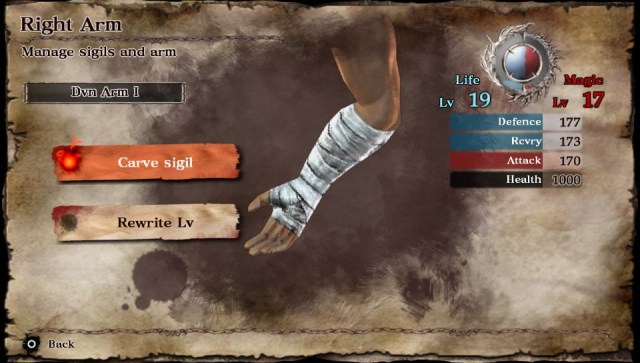
Graphically, Soul Sacrifice is impressive but not spectacular. Although there a decent amount of environments (all quests take place in fairly small arenas comprised of several open areas), initially you’re confined to the same three or four. They vary nicely, including an icy tundra, barren desert, flooded city, and the bizarre Icarus Pasture that seems to be a farm for giant, flapping angel wings (things like this remind you who the developers are). There’s a decent level of detail and the atmosphere is strong in every stage, but occasionally certain quests can have you running around wide spaces doing nothing until an enemy appears (you can press down on the D-Pad to activate a spiritual vision and highlight enemies, offering fonts and collectibles, which goes some way towards eliminating the problem). Character models are OK for the most part, but there aren’t many unique-looking allies. Most are recreated versions of the same model with tiny details changed – it’s not a major problem as you can only take two in to any quest, but it stops you growing too attached, which is a definite fault. The various offering effects are the most thrilling use of visuals – especially the gory, sometimes horrific, Black Rites – and the screen-filling bosses evoke a real sense of David versus Goliath.
Combined with the grimly majestic aesthetics, the sound does a great job of generating atmosphere. The eerie singing in the menu screen is catchy and reminiscent of Dark Souls’ opening cinematic, and the tormented screams of the souls trapped within the Archfiends you fight (splashed across the screen in blood-red subtitles) add an unsettling undertone to all the grunting, shouting, exploding and flesh-rending. Your allies will call out during battles, either to tell you to pace yourself, ask for help or comment when they’ve taken a beating. Some will offer themselves as sacrifice when they fall, while others will beg for your mercy. The lines are limited and can occasionally loop, which isn’t greatly annoying, but if you weren’t neck-deep in combat at the time, it would probably drive you mad. That said, the voice-acting is mostly high-quality, the voice of the narrator evoking memories of Simon Templeman’s Kain with his noble sneer and authoritative tones. As the background story is told through narrated, mostly-static illustrations on the Librom’s pages, his voice is the one you hear the most. The book itself resembles the The Evil Dead’s Necronomicon so closely it must be homage, while it’s tone of voice is very similar to the tome in the underrated console RPG, Nier.
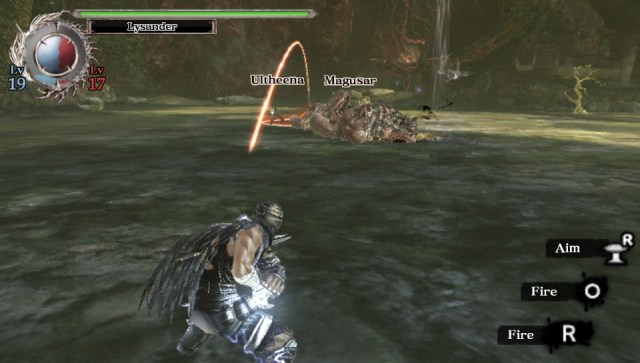
It’s a good sign when, after playing a game for close to twenty hours, the only regular niggles are a sporadically-unwieldy camera and a lack of variety in the combat dialogue. Deeper, broader concerns such as the repetitious nature of the missions are tempered somewhat by the option to take the action online, and the tedium is broken up by the quality of the storytelling. Soul Sacrifice is a huge game, its minimalist approach to quest design balanced out by an incredible selection of spells and attacks, with a huge scope for building a unique character able to take on anything this dark and twisted world can throw at you. The universe and its magic system are unique, forcing you to think carefully about the tools you take into every quest and punishing you for choosing wrong, while the save and sacrifice element is implemented fantastically, throwing up dilemmas that are as much about your own development as your moral alignment. More importantly, the narrative is deeper than it first appears, the universe richer and thicker than you’d expect (the Librom contains lore about everything you encounter), and it’s all topped off by arena-style combat that’s often nail-bitingly tense.
VERDICT: Soul Sacrifice can be an uphill battle given its difficulty and depth (at least where character progression is concerned), but it’s an immensely satisfying experience nonetheless. It does feel like an amalgamation of a lot of games, so that certain elements are familiar while at the same time completely new, and there isn’t a huge amount of variety in the quest set-ups. Also, the simple, uncluttered mission objectives may, in time, become tedious to some and others simply won’t wrap their heads around the intricate business of offerings, sigils, soul shards and Lacrima. However, those who allow themselves to become immersed in Soul Sacrifice’s shadowy, harrowing world will discover an incredibly playable, deep and unique game – and one of the best titles the Vita has to offer.

BRILLIANT. This is the mark of greatness, only awarded to games that engage us from start to finish. Titles that score 9/10 will have very few problems or negative issues, and will deliver high quality and value for money across all aspects of their design.




